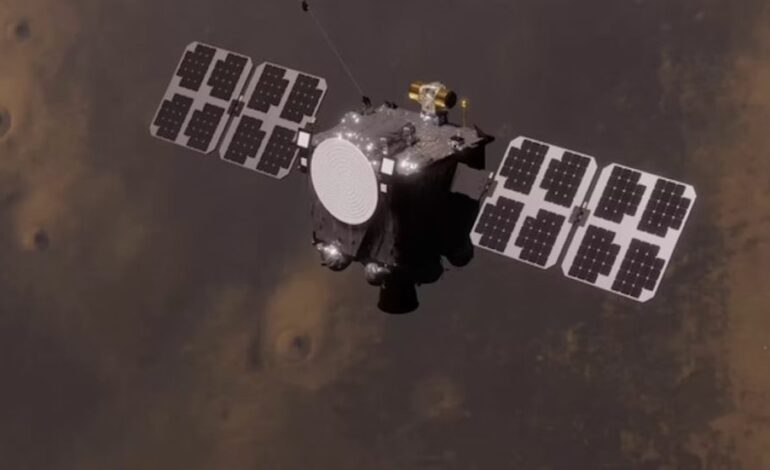NASA Launches Innovative Mission to Explore Mars’ Atmosphere

NASA has successfully launched its latest mission, known as ESCAPADE (Escape and Plasma Acceleration and Dynamics Explorers), sending two low-cost orbiters to Mars to investigate the planet’s atmosphere. The mission took off on November 13, 2025, aboard a Blue Origin New Glenn rocket. This initiative represents a significant step towards a future where numerous small spacecraft can explore the solar system, enhancing our understanding of space science while minimizing costs.
The ESCAPADE mission comprises two identical orbiters, referred to as Blue and Gold, which will collect simultaneous atmospheric data. This dual approach allows for enhanced scientific accuracy and provides a backup in case one of the spacecraft encounters issues. Each orbiter is roughly the size of a copy machine and is part of a growing trend towards miniaturization in the aerospace industry. Smaller spacecraft can achieve more with less, as traditional missions often allocate significant mass to transportation rather than research.
According to Rob Lillis, a researcher at UC Berkeley’s Space Sciences Laboratory, the redundancy of having two spacecraft enables a more affordable construction process. Even if one spacecraft fails, the mission can proceed with the other. This cost-efficiency is crucial as space exploration typically requires substantial investment, and ESCAPADE has a budget of approximately $80 million—a relatively low figure for interplanetary missions.
Unraveling Mars’ Atmospheric History
Mars once possessed a thicker atmosphere that supported liquid water on its surface, creating channels and gullies observable today. The ESCAPADE mission aims to uncover the reasons behind the significant loss of this atmosphere, which has left Mars with a mere 1% of Earth’s surface air pressure. Researchers will study remnants of the planet’s ancient magnetic field, which once protected its atmosphere, to understand how these changes occurred and the current rate at which Mars continues to lose its atmosphere.
The ESCAPADE orbiters will also investigate how Mars’ atmosphere interacts with solar wind, the stream of charged particles emitted by the Sun. These measurements are expected to provide insights into the historical conditions on Mars that could have supported life.
Space poses numerous challenges, including extreme temperatures and radiation exposure. Unlike Earth, where a magnetic field shields against harmful radiation, spacecraft must be engineered to withstand these harsh conditions. The ESCAPADE mission addresses these challenges while maintaining a budget by leveraging commercial technologies developed through prior NASA investments.
Innovative Trajectory and Future Implications
ESCAPADE will employ a novel trajectory to reach Mars, utilizing a route that enhances fuel efficiency. After launching, the spacecraft will first travel to the L2 Lagrange point, where gravitational forces from the Earth and the Sun balance each other. This phase will allow for data collection on the Sun over the course of a year before the orbiters use Earth’s gravity for an additional boost en route to Mars.
This innovative approach enables the spacecraft to carry less fuel—approximately 65% of their total mass—as opposed to the typical 80-85% seen in other missions. It also allows for more flexible departure windows, paving the way for future missions to Mars, potentially including human exploration.
The ESCAPADE mission exemplifies a new era in space exploration, emphasizing collaboration between government agencies, universities, and commercial enterprises. As scientists and engineers work together on this initiative, it serves as a blueprint for future explorations, demonstrating that space missions can be conducted more efficiently and affordably than ever before.
In conclusion, NASA’s ESCAPADE mission not only seeks to advance our understanding of Mars but also sets a precedent for innovative approaches to space exploration, making the cosmos more accessible for future generations of researchers and explorers.





